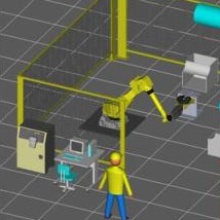Industrial robots are widely used in thermal spraying operations in order to assure process accuracy and reproducibility, as well as to increase worker´s safety. Robot path planning for the coating of free form geometries keeping constant the kinematic parameters can lead to complex robot paths and in some cases to unreachable robot configurations. The robot kinematics, which define the spraying path, spray angle, spray distance and spray velocity, are key parameters to control the heat and mass transfer to the substrate during the coating deposition, and they influence therefore the development of residual stresses.
Works for off-line planning of robot trajectories for thermal spraying operations taking into consideration the heat transfer to the component are carried out. The results of modelings and simulations are used as input to the programming of robot trajectories. By integration of programmable logic controllers, all the parameters of the process (e.g., distance, torch movement, and torch velocity) can be supervised, displayed and recorded.
P-678: M. FLORISTÁN, M. ; GADOW, R.: Manufacturing engineering in thermal spray technologies by advanced robot systems and process kinematics. In: Future Development of Thermal Spray Coatings, 1st Edition, Chapter 11, N. Espallargas (ed.), Woodhead Publishing (2015), S. 259–280, ISBN: 978-0-85709-769-9
P-638: FLORISTÁN, M.; MONTESINOS, J.; KILLINGER, J.; GADOW, R.: Robot trajectory planning for high quality thermal spray coating processes on complex shaped components. In: Thermal Spray 2012: Proceedings from the International Thermal Spray Conference and Exposition, ITSC 2012, Houston, Texas, May 2012, S. 448–453
P-414: CANDEL, A.; FLORISTÁN, M.; GADOW, R.: Optimized Robot Trajectory Generation for Thermal Spraying Operations and High Quality Coatings on Free-Form Surfaces. In: Surface & Coatings Technology 205 (2010), S. 1074–1079



